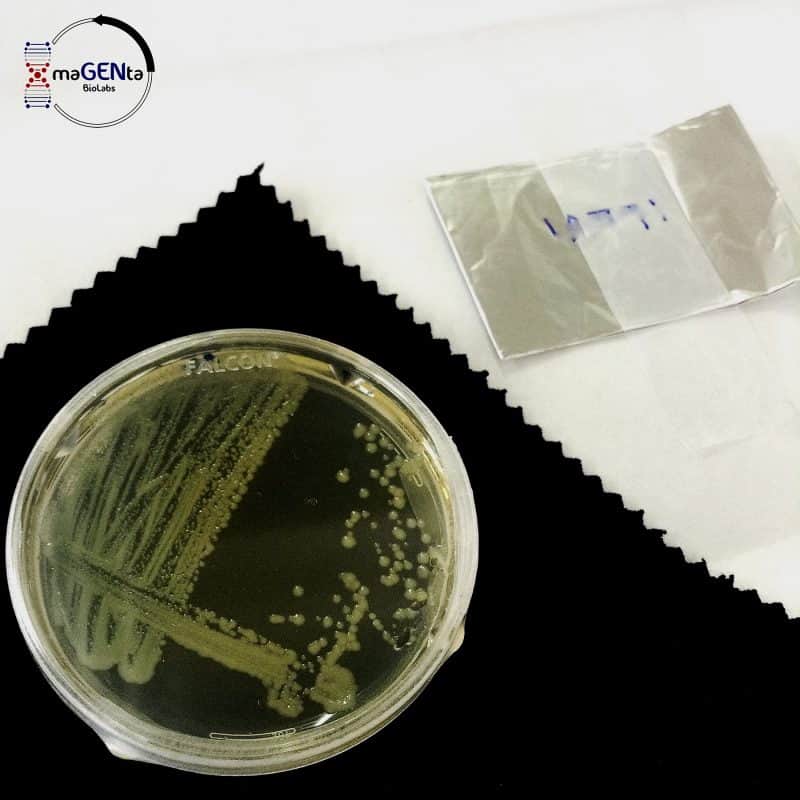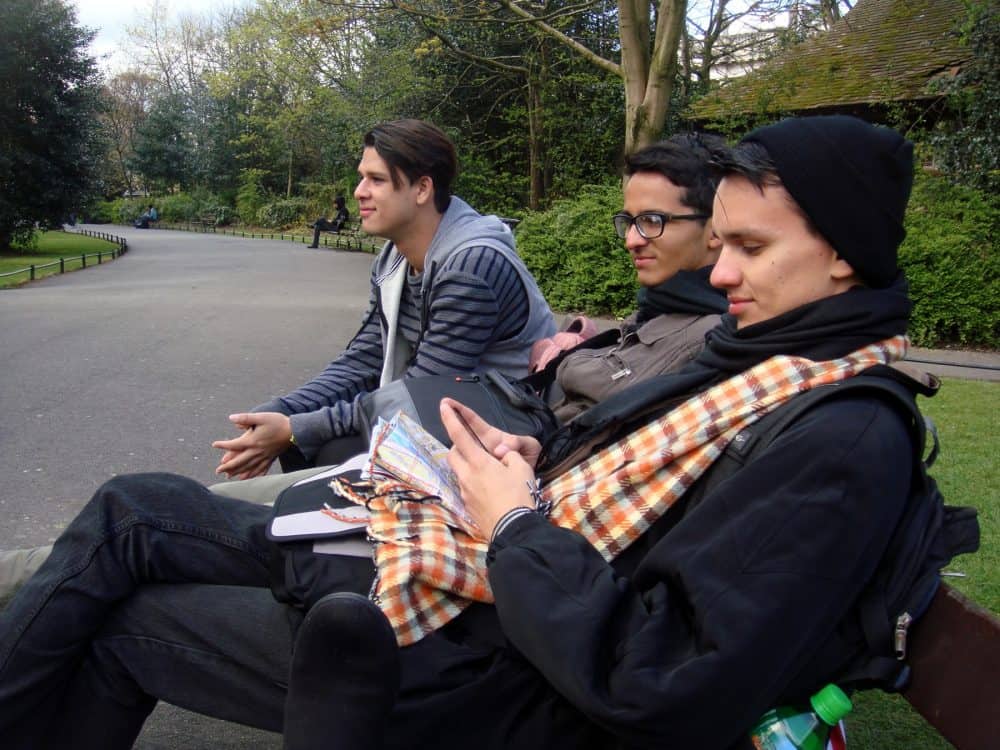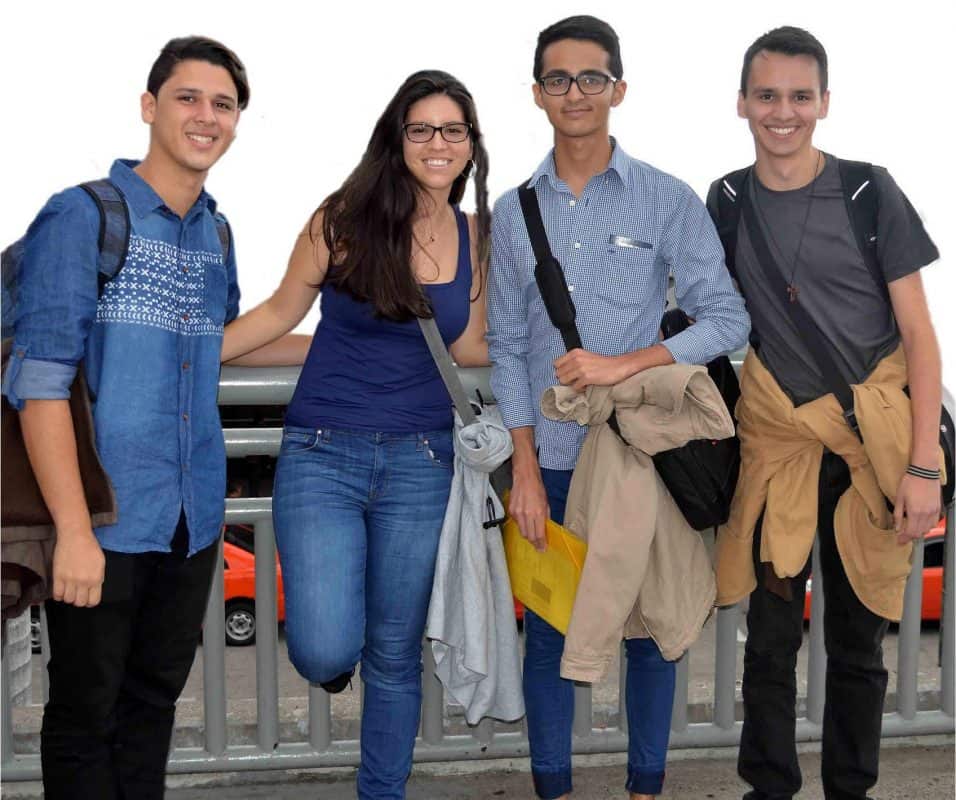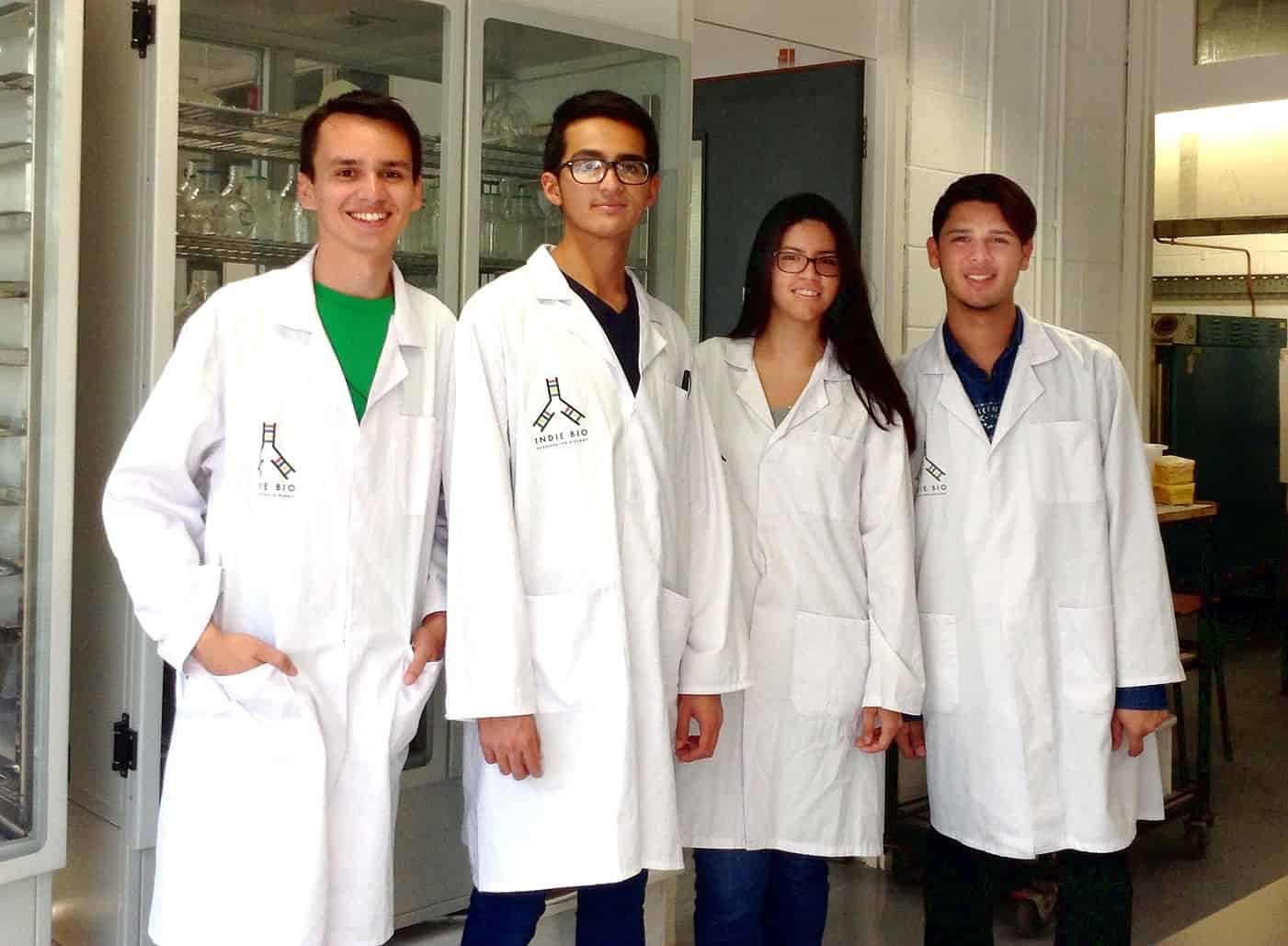Costa Rica has a new All-Star team — a Selección Nacional of sorts — though almost no one here knows who they are. Yet.
Like the country’s national soccer teams, this Sele is a group of the most talented young people from around the country who have gained international recognition, jetted off to Europe and arrived as welcomed guests. And yet there is not a soccer ball in sight when this team gets together: these all-stars kick around ideas instead. Their huddles take place not on a sideline, but rather in a gleaming laboratory packed with work tables, exhaust hoods, shelves of glassware, refrigerators full of mysterious chemicals in beakers and vials with strange codes written on them, and – well, OK, maybe the occasional leftover sandwich and half-finished soft drink.
The group of four, all students in the Biotechnology Engineering program at the Technology Institute of Costa Rica (TEC) in Cartago, were selected by San Francisco-based synthetic biology accelerator IndieBio to go to Cork, Ireland to develop their start-up biotechnology firm. This places funding, professional support and coaching at their disposal to help them develop their idea: using inexpensive materials including sugarcane molasses to produce hyaluronic acid.

“Hyaluronic acid” doesn’t slip off the tongue very easily, but you know it well — not by name, but because of what it means to humans. It is the substance produced in the body that lubricates joints and makes skin smooth and supple. It is part of the tissue that lies under the skin, and is found in connective, epithelial and neural tissues. It’s a gel-filled lattice that can be synthesized in a laboratory, but the most important lab where this mystery goo is produced is your own body.
The acid, known as HA, is a self-produced fountain of youth that gives you soft, smooth skin, elastic and wrinkle-free, glowing with health. Its useful properties, according to the young scientists, include its capacity to retain water a thousand times more than its molecular weight, and its high viscoelasticity ability. These properties are essential to many molecular functions and biochemical processes of living tissues such as joint lubrication and cell responses to inflammation. The commercially and inexpensively-produced HA that these young Tico scientists are working on could be used in a host of practical medical and cosmetic applications; now that their ideas are lowering the cost of production, many more uses may be found.
What’s more, this group of students is already dreaming of inspiring new levels of biotechnological innovation back home in Costa Rica so that more projects like theirs can see the light of day.
When I first wrote to the team from Costa Rica one evening from my home in Angeles Sur, it was seven hours later in Cork, 2 am on a chilly, rainy Irish night when they should have been asleep. They weren’t. I got an email reply within minutes. But who can blame them for being insomniacs? How could anyone sleep with so much excitement and so much to do?
Meet Rafael Lobo Marín, 21, and Sofía Miranda Durán, 20, both from San José; Marcelo Castro Alpízar, 21, from San Ramón, Alajuela; and José Pablo Méndez Sánchez, 20, from Guápiles, Limón.
Their alias: Team Magenta Biolabs.
I can’t believe you are still awake.
Marcelo: We can’t sleep. We are still getting used to the time difference.
Let’s start at the beginning. Did you have any early experiences that pushed you in the direction of science and bio-technology?
Marcelo: My childhood was full of curiosity, trying to learn how everything worked in nature, and even in the garden of my house. I lived in a rural town so I had close contact with nature, starting with my father’s hiking tours in the mountain when he needed to work on the land, to my mother asking for help in the garden chores… I realized that I wanted to work with things that were alive. At the beginning it was plants, but as I got deeper into biology, I started to wonder about being a scientist.
Rafael: As a child I remember pretending to be an astronaut. Since that time I have always admired [groundbreaking Costa Rican scientist and astronaut] Franklin Chang. He is one of my role models because he always has known clearly what he wanted in his life and he worked really hard to achieve it. In my first biology class I discovered my passion in that area; I had a great teacher.
José Pablo: I come from a rural area. My grandpa is a farmer; I remember waking up early to go and work with him and after that going to a river to swim, always paying extremely close attention to all the nature that was around me. I went to a scientific high school, and during that time my interest started to grow.
Sofía: Like many children, I dreamed of being an astronaut, doctor, or an important scientist — the kind you see in science books. My parents always supported my crazy dreams. I remember this like it was yesterday: the real microscope that my parents gave me. I still have it, and I will never forget spending so many hours pretending I was a scientist. Now I understand and appreciate all the support that my parents always provided.

How did you all meet? Did you know each other before going to TEC?
Rafael: No, and we started our studies in different years. We met at the “Startup Weekend Costa Rica” event during the Change Makers Edition — an entrepreneurship competition — in March of 2015.
Did your project start as a class assignment?
José Pablo: No. The idea was something that we heard about in class, but our project itself was designed by us completely as an extracurricular task.
How did you even know about hyaluronic acid (HA)? Were you being mentored by one or more particular professors?
José Pablo: One of our mentors told us that the HA industry was growing, and that there was no company making it in Costa Rica, or even Central America. The leader of our group, Rafael, had already done research for a university course to produce HA, so he told us that it might be a good idea, but we needed to redesign the whole process by ourselves to make it work. After discussing the idea with other mentors, we decided to start working on the technology necessary to make it real.
When was HA first discovered or synthesized?
Sofia: The first report of HA was in 1934 by Karl Meyer and his colleague John Palmer. They isolated an unknown substance from the vitreous fluid of cow’s eyes. In the 1950s you can find the first reports of the use of HA for humans during eye surgery. HA was initially taken from human umbilical cords and after that from rooster combs.
Marcelo: After the discovery of this new molecule, it started to become popular for the practical benefits of its uses.
How do you produce the hyaluronic acid? Is it synthesized by bacteria or fungi?
Sofía: We use a non-pathogenic bacteria to produce high-quality hyaluronic acid for the cosmetic industry. This substance is very important for anti-aging products because it helps to keep the skin moist and young and also has been proven as a good treatment for osteoporosis and rheumatoid arthritis when injected. HA used to be extracted with a chemical procedure or produced with a pathogenic bacteria whose growth requires a very expensive culture medium and makes toxins which are hazardous for humans. Our project will change this industry as we will be able to produce high-quality HA with no chemical or biological hazards.
What led you to try biosynthesis on sugarcane products?
José Pablo: Molasses is a sugar-rich product, and this makes it a perfect culture medium for our bacteria and for HA production. The economic benefits are great, because molasses as a substrate and growing medium is not nearly as expensive as chemical culture media are. I remember my grandfather feeding buckets of dark molasses to cattle. They loved lapping it up like ice cream. Growing a valuable product inexpensively is what makes our process unique. What makes us different is that we are using industrial and agricultural by-products as a cheap culture medium to produce the HA. The first by-product that we are using as our raw material is sugarcane molasses. We have a way to turn low value products into a very highly-valued and needed substance.
How did you get your opportunity for the trip to Ireland?
Rafael: We saw a Facebook ad from a group called Biotica which is related to the biotechnologies we are so interested in. We decided to apply – “Just to see what happens,” we told ourselves. It was a shot in the dark and we were so surprised when we got the email telling us that we were pre-accepted and that we were going to have an online meeting with [IndieBio director] Cathal Garvey for the selection of the finalists.
Marcelo: One hour after our meeting, we were still hanging out together. As we were watching the screen on my Samsung, we all saw the email arrive and read that we had been accepted. It had taken only an hour for them to pick us! We had no idea this was coming so quickly. We were in shock for a second, and then it hit us what this meant. We immediately went crazy and screamed and hugged each other and danced around. But we are nerdy enough to start working immediately. We knew that we were getting into something absolutely huge for us, so that would mean a lot of work ahead.

I am relieved to hear that you finally acted your age when you went crazy for a few minutes! What does your work in Ireland consist of?
Rafael: Basically we will develop the technology that we need: the whole laboratory and synthetic biology work to proof our concept and get a minimum amount of viable product.
Marcelo: When we were accepted in this accelerator program, we got hooked in immediately with a venture capital firm, SOSVentures, which has a partnership with IndieBio. SOSVentures specializes in making huge investments in ideas and startups in Europe. They invested $100,000 in our project, and in others too.
Why is Ireland a center of pharmacology and medical research?
Sofía: I looked it up! The Enterprise Europe network indicates that Ireland is the best European country to get investment in pharmaceutical companies. Amazingly, nine out of the top ten pharmaceutical companies are located in Ireland.
What is the goal of Magenta Biolabs?
Rafael: We are working on changing the paradigm about how people see business, venture capital, youth, science, and innovation in Latin America, and as far as we are able, around the world. In Costa Rica and Central America you rarely hear about venture capital and big money investments in unproven ideas since nobody likes to chance what little money they have in risky ideas. But Europe and the USA work a bit differently, and you find a lot of cash if you have an idea that seems to be good. Magenta Biolabs aims to help the Costa Rican startup environment to take advantage of the huge potential that our country has.
You mean that if you can show that bright people with innovative ideas in Costa Rica can be successful in start-up entrepreneurial ventures, maybe more of this will happen.
Group: (in one voice) YES!
When will you return to Costa Rica to finish your studies?
Marcelo: Our program here in Cork has been carefully planned out. The program ends on the first week of August, which gives us time time to rejoin the classes of the university for the second semester. The university gave us this sabbatical time off to make this unbelievable trip.
What is the gleam in your eye, or your wildest dream?
Marcelo: We have all talked about this. We want create an IndieBio-like program in Costa Rica and Central America where students like us would be able to find seed capital to develop their ideas. We want to change the way people see biotechnology. We want to change the local and national mindset of politicians and officials toward science and business. We want to show the world that young people like us can bring together science, technology, environment, and smart business and make profound changes in the world. Costa Rica’s youth can lead the way.
Stephen Duplantier has taught journalism, film and communication arts in the New Orleans area. He has made several documentary fllms on folklife in south Louisiana. Stephen has lived in Costa Rica for twelve years and edits Neotropica—the Costa Rican Magazine for Living in the New Tropics.






